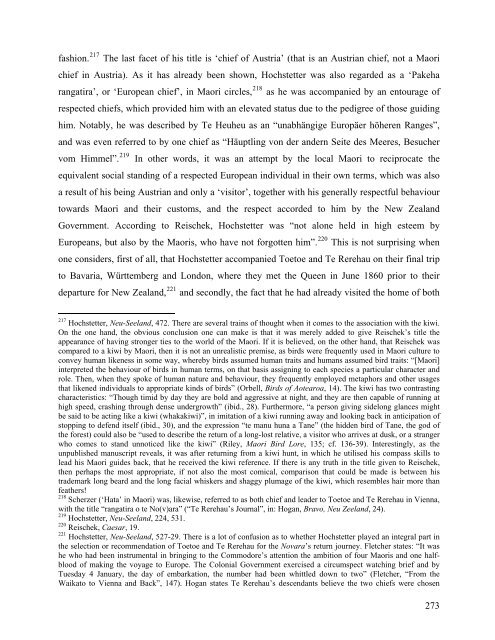General copyright and disclaimer - ResearchSpace@Auckland ...
General copyright and disclaimer - ResearchSpace@Auckland ...
General copyright and disclaimer - ResearchSpace@Auckland ...
You also want an ePaper? Increase the reach of your titles
YUMPU automatically turns print PDFs into web optimized ePapers that Google loves.
fashion. 217 The last facet of his title is ‘chief of Austria’ (that is an Austrian chief, not a Maori<br />
chief in Austria). As it has already been shown, Hochstetter was also regarded as a ‘Pakeha<br />
rangatira’, or ‘European chief’, in Maori circles, 218 as he was accompanied by an entourage of<br />
respected chiefs, which provided him with an elevated status due to the pedigree of those guiding<br />
him. Notably, he was described by Te Heuheu as an “unabhängige Europäer höheren Ranges”,<br />
<strong>and</strong> was even referred to by one chief as “Häuptling von der <strong>and</strong>ern Seite des Meeres, Besucher<br />
vom Himmel”. 219 In other words, it was an attempt by the local Maori to reciprocate the<br />
equivalent social st<strong>and</strong>ing of a respected European individual in their own terms, which was also<br />
a result of his being Austrian <strong>and</strong> only a ‘visitor’, together with his generally respectful behaviour<br />
towards Maori <strong>and</strong> their customs, <strong>and</strong> the respect accorded to him by the New Zeal<strong>and</strong><br />
Government. According to Reischek, Hochstetter was “not alone held in high esteem by<br />
Europeans, but also by the Maoris, who have not forgotten him”. 220 This is not surprising when<br />
one considers, first of all, that Hochstetter accompanied Toetoe <strong>and</strong> Te Rerehau on their final trip<br />
to Bavaria, Württemberg <strong>and</strong> London, where they met the Queen in June 1860 prior to their<br />
departure for New Zeal<strong>and</strong>, 221 <strong>and</strong> secondly, the fact that he had already visited the home of both<br />
217<br />
Hochstetter, Neu-Seel<strong>and</strong>, 472. There are several trains of thought when it comes to the association with the kiwi.<br />
On the one h<strong>and</strong>, the obvious conclusion one can make is that it was merely added to give Reischek’s title the<br />
appearance of having stronger ties to the world of the Maori. If it is believed, on the other h<strong>and</strong>, that Reischek was<br />
compared to a kiwi by Maori, then it is not an unrealistic premise, as birds were frequently used in Maori culture to<br />
convey human likeness in some way, whereby birds assumed human traits <strong>and</strong> humans assumed bird traits: “[Maori]<br />
interpreted the behaviour of birds in human terms, on that basis assigning to each species a particular character <strong>and</strong><br />
role. Then, when they spoke of human nature <strong>and</strong> behaviour, they frequently employed metaphors <strong>and</strong> other usages<br />
that likened individuals to appropriate kinds of birds” (Orbell, Birds of Aotearoa, 14). The kiwi has two contrasting<br />
characteristics: “Though timid by day they are bold <strong>and</strong> aggressive at night, <strong>and</strong> they are then capable of running at<br />
high speed, crashing through dense undergrowth” (ibid., 28). Furthermore, “a person giving sidelong glances might<br />
be said to be acting like a kiwi (whakakiwi)”, in imitation of a kiwi running away <strong>and</strong> looking back in anticipation of<br />
stopping to defend itself (ibid., 30), <strong>and</strong> the expression “te manu huna a Tane” (the hidden bird of Tane, the god of<br />
the forest) could also be “used to describe the return of a long-lost relative, a visitor who arrives at dusk, or a stranger<br />
who comes to st<strong>and</strong> unnoticed like the kiwi” (Riley, Maori Bird Lore, 135; cf. 136-39). Interestingly, as the<br />
unpublished manuscript reveals, it was after returning from a kiwi hunt, in which he utilised his compass skills to<br />
lead his Maori guides back, that he received the kiwi reference. If there is any truth in the title given to Reischek,<br />
then perhaps the most appropriate, if not also the most comical, comparison that could be made is between his<br />
trademark long beard <strong>and</strong> the long facial whiskers <strong>and</strong> shaggy plumage of the kiwi, which resembles hair more than<br />
feathers!<br />
218<br />
Scherzer (‘Hata’ in Maori) was, likewise, referred to as both chief <strong>and</strong> leader to Toetoe <strong>and</strong> Te Rerehau in Vienna,<br />
with the title “rangatira o te No(v)ara” (“Te Rerehau’s Journal”, in: Hogan, Bravo, Neu Zeel<strong>and</strong>, 24).<br />
219<br />
Hochstetter, Neu-Seel<strong>and</strong>, 224, 531.<br />
220<br />
Reischek, Caesar, 19.<br />
221<br />
Hochstetter, Neu-Seel<strong>and</strong>, 527-29. There is a lot of confusion as to whether Hochstetter played an integral part in<br />
the selection or recommendation of Toetoe <strong>and</strong> Te Rerehau for the Novara’s return journey. Fletcher states: “It was<br />
he who had been instrumental in bringing to the Commodore’s attention the ambition of four Maoris <strong>and</strong> one halfblood<br />
of making the voyage to Europe. The Colonial Government exercised a circumspect watching brief <strong>and</strong> by<br />
Tuesday 4 January, the day of embarkation, the number had been whittled down to two” (Fletcher, “From the<br />
Waikato to Vienna <strong>and</strong> Back”, 147). Hogan states Te Rerehau’s descendants believe the two chiefs were chosen<br />
273















